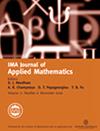Snaking without subcriticality: grain boundaries as non-topological defects
IF 1.4
4区 数学
Q2 MATHEMATICS, APPLIED
引用次数: 5
Abstract
Non-topological defects in spatial patterns such as grain boundaries in crystalline materials arise from local variations of the pattern properties such as amplitude, wavelength and orientation. Such non-topological defects may be treated as spatially localized structures, i.e. as fronts connecting distinct periodic states. Using the two-dimensional quadratic-cubic Swift–Hohenberg equation, we obtain fully nonlinear equilibria containing grain boundaries that separate a patch of hexagons with one orientation (the grain) from an identical hexagonal state with a different orientation (the background). These grain boundaries take the form of closed curves with multiple penta-hepta defects that arise from local orientation mismatches between the two competing hexagonal structures. Multiple isolas occurring robustly over a wide range of parameters are obtained even in the absence of a unique Maxwell point, underlining the importance of retaining pinning when analysing patterns with defects, an effect omitted from the commonly used amplitude-phase description. Similar results are obtained for quasiperiodic structures in a two-scale phase-field model.没有亚临界的蛇形:晶界作为非拓扑缺陷
空间图案中的非拓扑缺陷(如晶体材料中的晶界)是由图案性质(如振幅、波长和取向)的局部变化引起的。这种非拓扑缺陷可以被视为空间局部化结构,即连接不同周期状态的前沿。使用二维二次三次Swift–Hohenberg方程,我们获得了包含晶界的完全非线性平衡,这些晶界将一片具有一个取向的六边形(晶粒)与具有不同取向的相同六边形状态(背景)分离。这些晶界采用具有多个五-七缺陷的闭合曲线的形式,这些缺陷由两个竞争的六边形结构之间的局部取向失配引起。即使在没有唯一的麦克斯韦点的情况下,也可以获得在宽参数范围内稳健出现的多个等值线,这突出了在分析具有缺陷的图案时保持钉扎的重要性,这一效果在常用的振幅-相位描述中被省略。在两尺度相场模型中,准周期结构也得到了类似的结果。
本文章由计算机程序翻译,如有差异,请以英文原文为准。
求助全文
约1分钟内获得全文
求助全文
来源期刊
CiteScore
2.30
自引率
8.30%
发文量
32
审稿时长
24 months
期刊介绍:
The IMA Journal of Applied Mathematics is a direct successor of the Journal of the Institute of Mathematics and its Applications which was started in 1965. It is an interdisciplinary journal that publishes research on mathematics arising in the physical sciences and engineering as well as suitable articles in the life sciences, social sciences, and finance. Submissions should address interesting and challenging mathematical problems arising in applications. A good balance between the development of the application(s) and the analysis is expected. Papers that either use established methods to address solved problems or that present analysis in the absence of applications will not be considered.
The journal welcomes submissions in many research areas. Examples are: continuum mechanics materials science and elasticity, including boundary layer theory, combustion, complex flows and soft matter, electrohydrodynamics and magnetohydrodynamics, geophysical flows, granular flows, interfacial and free surface flows, vortex dynamics; elasticity theory; linear and nonlinear wave propagation, nonlinear optics and photonics; inverse problems; applied dynamical systems and nonlinear systems; mathematical physics; stochastic differential equations and stochastic dynamics; network science; industrial applications.

 求助内容:
求助内容: 应助结果提醒方式:
应助结果提醒方式:


